About Persian Bakhtiari Rugs
Overview
Imagine a culture that can trace it's roots back to antiquity - a nomadic people that has inhabited the same region for nearly that entire period of time - and who can lay claim to being the largest and most purely Iranian of all the Persian tribes and, furthermore, whose spoken language is closely related to the oldest known forms of Persian. Although most known today for their textile production and, more specifically, for both the beauty and the quality of the rugs they make ... that is just a small part of the story.
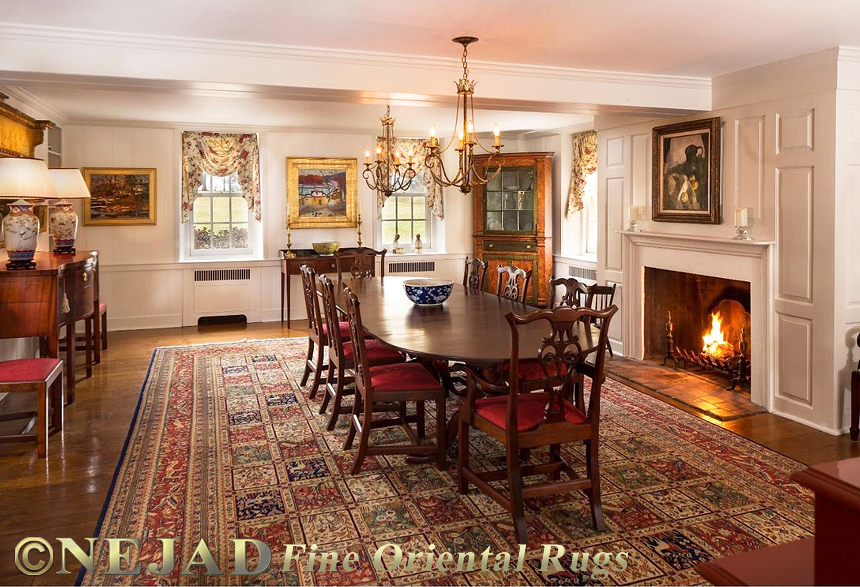
A magnificent example of a large 12' × 18' Persian Bakhtiari
hand-knotted wool carpet from the Nejad Signature Masterpiece Collection.
A Distinctive & Unique Style
The Bakhtiari Rug Style - typical theme for Bakhtiari carpets - is as unique and individualistic as the peoples who are attributed with it's creation. Bakhtiari rugs can be readily identified by their typical repeated rectilinear floral or garden-inspired patterns. Of these, perhaps the most well-known of the Bakhtiari rug designs is the Khesti (shown here). In this pattern the rug field is geometrically sub-divided into symmetrical squares or rectangles that feature contrasting imagery and color schemes - each compartment elegantly rendered with finely detailed portrayals of both animals and plant life.
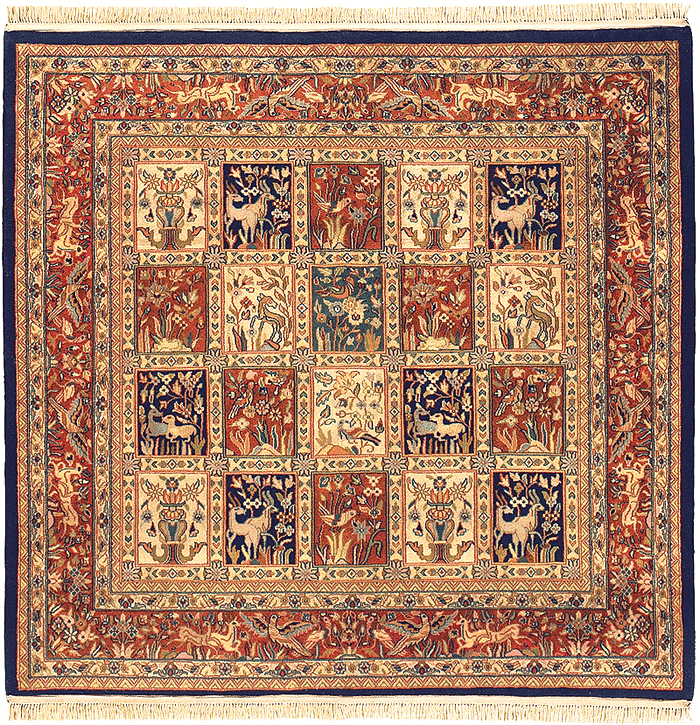
Nejad offers an 8' 6" × 8' 6" square as well as a
6' × 6' square version of this Persian Bakhtiari M010MTRT rug.
Squares ... or Diamonds?
Another Bakhtiari noteable design, a variation on the repeated squares Khesti motif (above), features the field of the rug layed out in an overall lattice scheme and populated with repeated diamonds rather than squares. Of the first two examples shown below, the rug on the left, replete with bold pattern and vibrant color palette, has a more tribal appearance, while the adjacent rug to it's right, in contrast, has both a more sophisticated and subdued color scheme and design.

These Bakhtiari rugs, offered by Christie's, New York,
feature a repeated diamond motif within a lattice design framework.
Bakhtiari carpets may also feature either a center medallion or an all over design motif - which typically includes floral ornament, but not usually a curvelinear design. The Bakhtiari rug below (on the left) was artfully conceived as an overall lattice-like arrangement that is rather cleverly disguised by the free form detailing of the surface design - giving the rug an all-over design appearance rather than a geometric one, while the rug on the right (below) features an unusually shaped florid medallion superimposed over a telescoping diamond architecture.
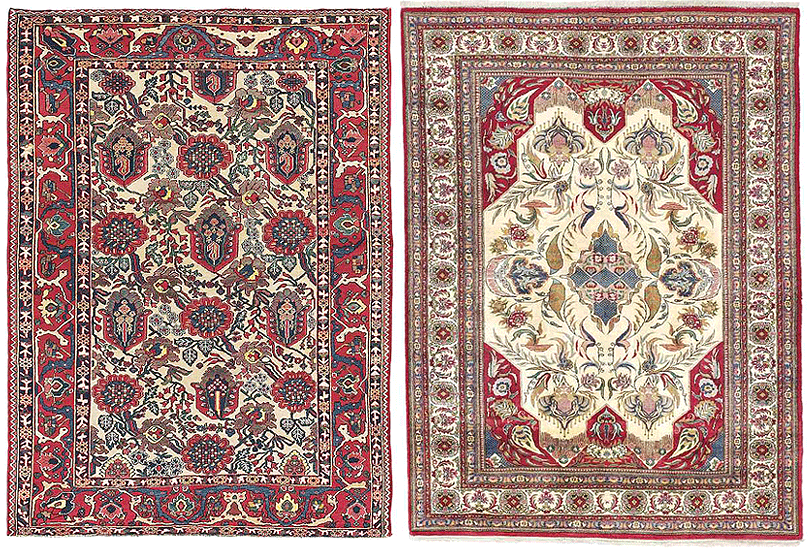
View Underlying Structural Concept View Underlying Structural Concept
( MouseOver ) ( MouseOver )
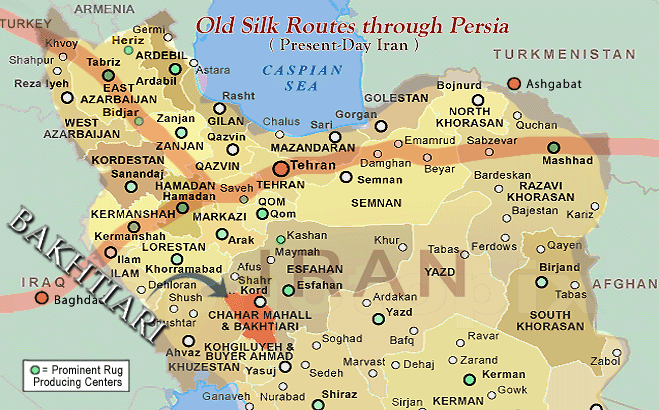
Chaharmahal and Bakhtiari, Iran

The Baktiari community has adapted its migratory way of life to the harsh and peculiar
climate of the central Zagros Mountain region
The Bakhtiari tribe inhabits, and where their migratory cycle encompasses, an area approximately 25,000 square miles (67,000 sq. km) straddling the Central Zagros Mountain range in western Iran. The sustenance of their numerous sheep, cattle, or goat herds necessitates a seasonal migration with their livestock from the high plateau pastures west of the city of Esfahan, where they spend the summer, to the lowland plains in the province of Khuzistan for winter grazing.
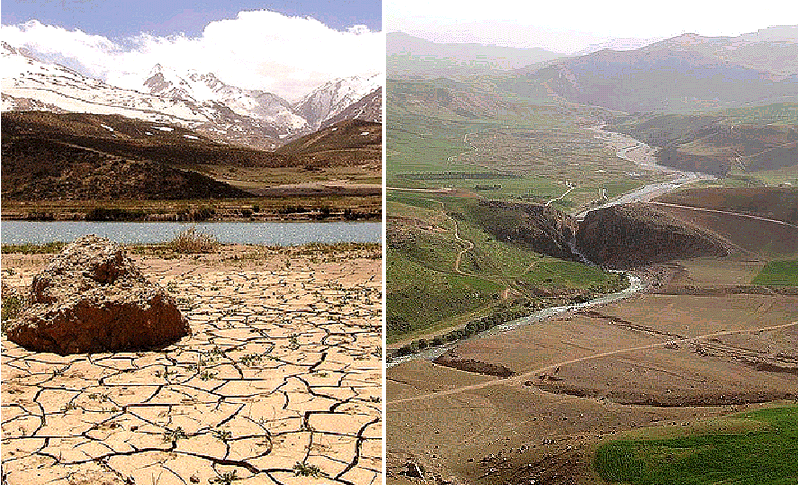
They migrate from the high plateau pastures west of Esfahan, in summer, to the lowland plains
of Khuzistan for winter grazing.
In this epic movement of people and animals across harsh and dangerous mountainous terrain there is always the inherent risk of facing unpredictable, potentially disastrous, conditions - such as the danger of early snowfall, flooding mountain rivers, and/or lack of grazing. Typical scenarios include crossing turbulent rivers on inflated goatskin rafts or hoisting animals on cables suspended over deep water or gorges. These combined hazards customarily took a heavy toll, but in recent years the government has assisted in improving the safety of the migration route by building bridges and setting up fodder supplies at strategic points along the way.
A Nomadic People
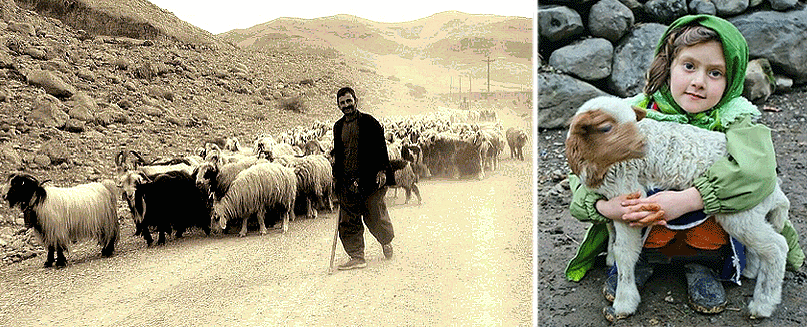
The nomadic Bakhtiari live within the tribal territory called the Baktiari Country, a vast area stretching from the Dez river and Ram Hormoz on the west to Daran and the outskirts of the capitol city Shahrekord on the east. Rugged individualists who embody longstanding cultural imperatives, their epic migration is among the most impressive and spectacular to be witnessed anywhere. This seasonal migration is necessary because of the prevalence of cold and snow in the North Khorasan Province from October to April and heat and drought in the Semnan Province from May to September, as well as the exhaustion of the pastures after several months of intensive grazing. Thus nomadism remains the only feasible strategy for the efficient pursuit of livestock raising in this region.

Bakhtiari women (left) migrate with their pack mules
vs. Qashqai nomadic family (right) of Turkish origin
Of their estimated 800,000 population, one third or more of the Bakhtiari tribe are nomadic pastoralists while the majority are settled agriculturists who inhabit the many towns and villages in Chaharmahal in the Faridan district down to Esfahan, and in Khuzistan down to Ahvaz. This more sedentary and settled faction of the Bakhtiari tribe was more suited to adopt the pursuit of commercial rug weaving that required larger looms that would otherwise be impractical to frequently tranport.

The vertical black-striped white tunic, black pants and cap
practically serve as a uniform for Bakhtiari males
Though weaving and rug making have been the principal handicraft of Bakhtiari women for several centuries it is only since the early 19th century that their highly regarded rugs have been woven commercially for export around the globe. These colorful carpets are typically woven on horizontal looms with single rows of threads - the wool which they use come from their own sheep. Due to political instability production entirely ceased in the 1930s. Production subsequently resumed on a large scale both in Iran and in several other locations throughout the middle east but, once again, due to political instability, the rug-weaving industry faces an all but certain future.

A customary headdress here confers a dignified, even aristocratic, quality on each
of these lovely Persian women
Consumer Notes
Bakhtiari carpets are traditionally constructed on a cotton foundation (warp) using wool (weft)
taken from the herds of the producing tribe - resulting in unique carpets that differed depending
upon the varying characteristics of the wool (from dull to lustrous). However, and even though
the rugs are still woven by hand, the industry today is more regulated with regards to the
sourcing of wool and dyes and thereby can produce a more consistent quality product.
The best carpets with the highest knot density - and typically woven by the most-experienced
(older) craftswomen - are referred to in the trade as Bibibaff and are top of the
line. The terms Saman and Hori are also used to indicate grade or quality
(rather than merely as geographical reference) - Saman pieces are rated just slightly beneath
Bibibaff while the Hori carpet - of looser weave but generally acceptable quality -
are considered enty-level and more widely affordable.

The Nejad Signature Masterpiece Collection features strikingly
beautiful high quality hand woven rugs in both traditional and transitional designs - each rug
is masterfully hand-knotted using superior quality New Zealand semi-worsted wool featuring 100%
Wool pile.These high fashion designer rugs can transform any living space into a fabulously
inspired interior. The Bakhtiari M010MTRT rug from Nejad is available
in runners ranging from 6' up to 24',
both 8' 6" × 8' 6" and 6' × 6' square sizes, and standard rectangular sizes from
4' × 6' up to 12' × 18'.
Currently Nejad is offering the following Khesti Bakhtiari rug for sale:
#M010MTRT Bakhtiari
About:
Tabriz Antique Rugs | Heriz Antique Rugs | Mashhad Antique Rugs | Sarouk Antique Rugs | Kashan Antique Rugs
Kerman Antique Rugs | Serapi Antique Rugs | Bidjar Antique Rugs | Karabagh Antique Rugs | Kazak Antique Rugs
Turkeman Antique Rugs | Kurdish Antique Rugs | Farahan Antique Rugs | Darjazin-Hamadan Antique Rugs
Hereke Antique Rugs | Akstafa Antique Rugs | Mudjar Antique Rugs | Chichi Antique Rugs | Dagestan Antique Rugs
Senneh Antique Rugs | Shirvan Antique Rugs | Beluch Antique Rugs | Peking Antique Rugs | Qum Antique Rugs
French Aubusson Antique Tapestry
